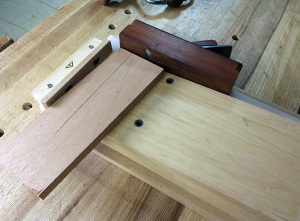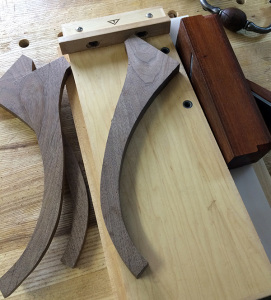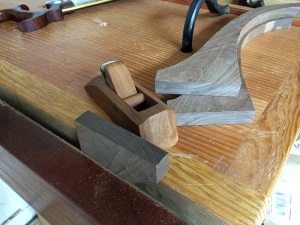Doing it The Hard Way
 Using jigs and work aids are great, but learning about the fundamentals behind those “shortcuts” will serve you better in the long run. So while it may seem like you are steepening the learning curve, you will appreciate the added skill at some point down the road.
Using jigs and work aids are great, but learning about the fundamentals behind those “shortcuts” will serve you better in the long run. So while it may seem like you are steepening the learning curve, you will appreciate the added skill at some point down the road.
Hand Tool School members know I do things the hard way a lot on purpose to teach the underlying skills. Things like squaring up the edges of panel parts independently instead of match planing or squaring the end grain of a board without a shooting board. Of course then they accuse me of cheating when I pull out a shooting board to square up the end of a typical board. Hey if the tool is there why not use it, because I know how to flatten and square a board on 6 sides and I’m not impressing anybody if I keep doing it the hard way. But somewhere looming in the future will be a time when that shooting board won’t work. I’m working on just such a project right now.
 The legs for this tripod table have no reference faces once the shape is sawn out. I must saw it out first since I need to position the legs so the long grain runs along the entire length of it for the best strength. Do I build a special jig for my shooting board that will hold the work piece at the perfect angle or compound angle? This seems like a lot of extra work that could only lead to compounded errors. I suppose if I had a whole bunch of ends to do, but with only 3 legs it just seems silly and definitely a lot slower. Since I need two flat and square faces I suppose I could use the shooting board for the second face but I still have to flatten and square the first face and that won’t work on the board.
The legs for this tripod table have no reference faces once the shape is sawn out. I must saw it out first since I need to position the legs so the long grain runs along the entire length of it for the best strength. Do I build a special jig for my shooting board that will hold the work piece at the perfect angle or compound angle? This seems like a lot of extra work that could only lead to compounded errors. I suppose if I had a whole bunch of ends to do, but with only 3 legs it just seems silly and definitely a lot slower. Since I need two flat and square faces I suppose I could use the shooting board for the second face but I still have to flatten and square the first face and that won’t work on the board.
 So I fall back on the fundamental skills and put the shooting board back under the workbench and grab a block plane. I need to flatten the joinery face and square it, then create a narrow face at the top of the leg that is square to the joinery face. This second face will mostly be hidden inside the sliding dovetail but a small portion is visible and needs to mate cleanly with the column. I find this kind of detail work to be really soothing. No jigs, just freehand work with the plane (though I suppose a plane is a jig right?) where I take a pass check with a square and take another until I have refined the face. It reminds me just how important it is to be able to execute the fundamental skills that lay beneath the fixtures, appliances, and jigs that we create to make our work easier.
So I fall back on the fundamental skills and put the shooting board back under the workbench and grab a block plane. I need to flatten the joinery face and square it, then create a narrow face at the top of the leg that is square to the joinery face. This second face will mostly be hidden inside the sliding dovetail but a small portion is visible and needs to mate cleanly with the column. I find this kind of detail work to be really soothing. No jigs, just freehand work with the plane (though I suppose a plane is a jig right?) where I take a pass check with a square and take another until I have refined the face. It reminds me just how important it is to be able to execute the fundamental skills that lay beneath the fixtures, appliances, and jigs that we create to make our work easier.
Sometimes “the hard way” is much easier.
Your Turn
Do you have a similar example where the hard way is actually easier? Please share your experience in the comments below.


